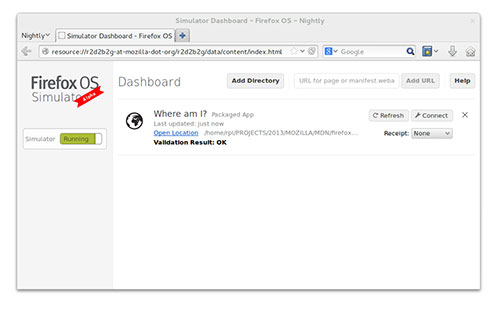It’s a good day for Firefox OS developers as we are releasing version 4.0 of the Firefox OS Simulator to the masses. In particular, this release is a boon for those developers that want to make money using their app in the Marketplace.
What’s New in 4.0

An overview shot of the revised Dashboard
New Connect Button
There is a new ‘Connect’ button for each app that opens a developer toolbox connected to that specific app. This means that you won’t have to search through messages in the Console or filter through scripts in the Debugger in order to find information specific to your app.
Testing Receipts for Paid Apps
There is now a dropdown menu in each app’s dashboard where you can select a receipt type. The simulator add-on will then download a test receipt from a Marketplace receipt service and reinstall the app using it. This way you can test receipt verification with the various types of receipts that you may require – valid, invalid, and refunded.

The new Connect button, Refresh Button, and Receipts drop-down
Remote CSS Styling
If you connect to an app while using a Nightly or Aurora build of Firefox, there is a Style Editor tool you can use to edit the style sheets for your app. Changes are applied instantaneously.

Live editing the Firefox OS Boilerplate app to have a less than charming red background
Simulated Touch Events
Gaia’s touch events simulation has been integrated such that interacting with the Simulator using a mouse now generates real touch events. This fixes a myriad of issues in core Gaia apps that assume touch interactions. It also means you can test third party apps that rely on touch events without needing to fall back to mouse events.
Hidden Feature: Shift-Ctrl/Cmd-R
When using the keyboard shortcut Ctrl-R (Cmd-R on Mac) to refresh an app, if you also hold down the Shift key, then the Simulator will clear persistent data such as AppCache, localStorage, sessionStorage, and IndexedDB while refreshing the app.
Check Out The Simulator Walkthrough
Still want to get into grittier details? Check out the simulator walkthrough to get a deep dive into the details of the Simulator, and the MDN documentation here.
Download and Install the Simulator
You can install or update the Simulator from the add-ons website.
Bugs? Feedback?
Leave general feedback in the comments below, we’re listening! If you encounter a bug we would be grateful if you could file it here.
About Angelina Fabbro
I'm a developer from Vancouver, BC Canada working at Mozilla as a Technical Evangelist and developer advocate for Firefox OS. I love JavaScript, web components, Node.js, mobile app development, and this cool place I hang out a lot called the world wide web. Oh, and let's not forget Firefox OS. In my spare time I take singing lessons, play Magic: The Gathering, teach people to program, and collaborate with scientists for better programmer-scientist engagement.


8 comments